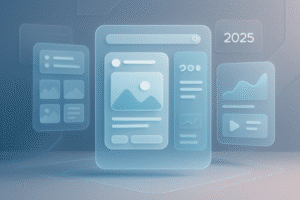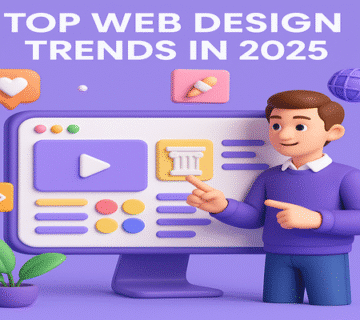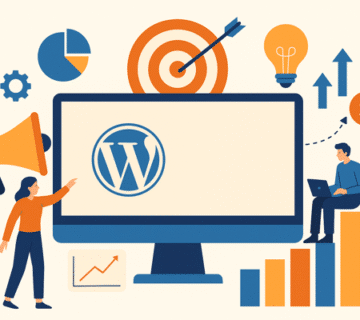The Importance of Web Design in 2025
Introduction to Web Design
Web design is the process that involves planning and implementing the appearance and interactivity of websites. It is a fundamental element in developing any site, going far beyond aesthetics.
Web design plays a key role in enhancing the user experience, which is vital in the modern digital age. When visitors interact with a website, they assess how intuitive and cohesive it is—an impression that can impact their perception either positively or negatively.
In a world full of options, an attractive and user-friendly design has become a priority for brands looking to stand out in digital marketing. A well-structured and modern design conveys a professional impression of the brand and supports its goals. This is closely tied to user satisfaction and engagement.
A well-designed website encourages users to stay longer and increases the likelihood of converting them into customers. Therefore, web designers should aim to strike the perfect balance between aesthetics and functionality.
Moreover, web design plays a vital role in search engine optimization (SEO). Innovations in layout design and page speed are factors that help boost a website’s ranking in search results.
Evaluating web design elements such as navigation, graphic optimization, and effective use of white space contributes to the overall performance of a site and supports business goals. In this context, web design should be a top priority for companies and institutions to keep pace with technological advancements and modern marketing strategies.

Emerging Trends in Web Design
By 2025, web design trends are expected to be heavily influenced by rapid technological developments. One of the key trends is responsive design, which enables websites to adapt seamlessly across all screen sizes—from smartphones to desktop computers.
With mobile device usage on the rise, responsive design has become essential for delivering a smooth and effective user experience. It allows users to access content quickly and easily, enhancing website performance.
Additionally, Artificial Intelligence (AI) is becoming an integral part of future web design. By leveraging big data and advanced algorithms, web designers can create personalized experiences that better meet users’ needs.
AI can be used to analyze user behavior and offer smart recommendations, improving overall user experience and boosting engagement.
Another important factor is page speed and interactivity. A growing focus on performance highlights the need for smooth, fast-loading websites.
Interactive elements such as animated buttons and dynamic icons are becoming central to design, making websites more appealing and enhancing user satisfaction. Understanding and applying these trends will lead to more innovative and engaging websites in the future.
Technology and Its Impact on Web Design
In recent years, web design has undergone significant technological transformations that have reshaped how websites are built and developed.
Technologies such as HTML5, CSS3, and JavaScript are at the core of web design in 2025. These technologies not only enhance the user experience but also expand the creative capabilities of designers and developers.
HTML5, the latest version of the markup language, introduces many new features such as native support for multimedia content without relying on external plugins—making content display smoother and more accessible.
CSS3 adds advanced styling features like transitions and gradients, enabling designers to create more visually appealing interfaces. Meanwhile, JavaScript, through modern libraries and frameworks like React and Vue.js, simplifies building dynamic interfaces, increasing design efficiency.
The rise of component-less web design also deserves mention. This approach involves creating lightweight, fast websites using minimal code, reducing reliance on traditional content management systems (CMSs) and giving designers more creative freedom.
These technological advances have radically transformed web design practices, empowering designers to craft seamless user experiences across devices and platforms. Technology is shaping the face of web design, making it more complex and vital in our ever-evolving digital world.
User Experience (UX) and Web Design
User Experience (UX) plays a pivotal role in web design. It concerns how visitors interact with a site and how satisfied they are with that experience. A good design considers users’ needs and can increase conversion rates and customer loyalty.
UX is influenced by various design elements such as page layout, color schemes, and graphics. Consistency and clarity are essential to help users navigate effortlessly. Designers must also consider their target audience and tailor interfaces accordingly. A UX-focused design process involves research, testing, and continuous analysis to ensure effectiveness.
Key techniques for enhancing UX include responsive design, which ensures optimal display across devices. Additionally, easy interaction with elements like buttons and forms boosts engagement. Providing well-structured, easy-to-read content helps users find what they’re looking for more quickly, improving their experience.
As we approach 2025, UX-centered design will be more important than ever in shaping the future of web development.

Mobile Compatibility
Given the fast-paced technological evolution and shifting consumer behavior, designing mobile-compatible websites is becoming a critical priority by 2025. Recent statistics show that nearly 75% of users access the internet through mobile devices. This is not a passing trend—it’s a fundamental shift.
By creating mobile-friendly sites, businesses can significantly increase user engagement. A seamless mobile experience is a strong magnet for visitors, resulting in higher conversion rates. Users prefer websites that adapt to various screen sizes, offering easy, hassle-free access to content.
Responsive layouts make it easier to read text and navigate pages, improving the overall experience.
With mobile usage expected to keep growing, companies and designers must develop strategies tailored to mobile-first users. Design should account for fast loading times, SEO optimization, and customized interfaces that resonate with mobile audiences.
In a rapidly changing digital environment, mobile compatibility is no longer optional—it’s essential for sustaining success.
SEO and Its Relationship with Web Design
Search Engine Optimization (SEO) is a fundamental factor that greatly influences website rankings. In 2025, it’s crucial to incorporate modern SEO techniques into web design to enhance visibility and increase traffic.
Good design is not just about aesthetics—it must also consider the technical aspects that affect search engine indexing.
One of the most critical design aspects is page loading speed. Studies show users tend to abandon slow-loading websites. Therefore, SEO depends heavily on page speed, which is influenced by image optimization, caching, and reducing file sizes. These enhancements not only improve SEO but also provide a better user experience.
The site’s internal structure also plays a key role in SEO. Clear navigation allows search engines to crawl and index content more efficiently. Each page should have well-defined headings, accurate meta descriptions, and relevant keywords to improve discoverability.
UX also factors into SEO; search engines assess how users interact with a site to determine its quality.
In short, integrating SEO into web design involves a multi-layered strategy. Success in search rankings depends on how well these strategies are implemented, requiring in-depth, balanced knowledge of current SEO best practices.
Web Design Security
In today’s dynamic web environment, security is one of the most important considerations in design. With increased internet use across all sectors, designers must prioritize user safety.
Secure web design involves being aware of the latest threats, including cyberattacks and data breaches.
Designers should follow essential protocols like HTTPS, which encrypts data exchanged between users and servers—especially important for sensitive information such as login credentials and banking details.
Other important practices include implementing strong password policies and using firewalls and encryption tools to protect against malware and network-based attacks. Regular security audits help identify and fix vulnerabilities.
Beyond implementation, designers should educate users about online safety by offering informative content, further building trust in the platform.
Ultimately, security in web design is critical for a site’s long-term success and user retention. By following current protocols and best practices, a secure and trustworthy digital environment can be created for all.
Sustainable Web Design
With growing global awareness around environmental issues, sustainable web design has become a major focus. Sustainable design refers to methods that reduce the environmental impact of web development.
These include lowering energy consumption and using renewable resources. Performance optimization is a key aspect: faster-loading pages consume less energy. Designers can achieve this by optimizing images and files, and minimizing server requests. These practices not only improve UX but also reduce the environmental footprint of websites.
Green hosting is another step toward environmentally responsible design. These hosting providers use renewable energy sources, reducing carbon emissions.
Additionally, sustainable UI/UX design promotes long-term maintainability, reducing the need for frequent updates and resource-heavy changes.
All of these practices make sustainable web design a smart choice for environmentally-conscious brands, helping them balance performance with ecological responsibility. As 2025 approaches, sustainable design will be a cornerstone of the digital future.
Conclusion and Future Insights
Ultimately, web design stands as a vital pillar of modern digital communication. Throughout this article, we’ve explored its importance in enhancing user experience and increasing engagement.
With rapid advancements in technology, web design is expected to evolve significantly by 2025.
Emerging innovations in ICT will equip designers and developers with new tools, reshaping how online content is created and distributed.
One of the key takeaways is the importance of adapting to changing user expectations. Designers must adopt flexible methodologies aligned with new trends such as responsive design and AI-driven experiences. Understanding user behavior and interactions will be central to the future success of web projects.
Sustainable design principles are also expected to grow. Rising awareness of environmental and social responsibility will push designers to create greener, more inclusive websites that serve a diverse range of users.
Looking ahead, web design will need to become smarter and more adaptive to meet new challenges. Through creative thinking and quick adaptation to technological changes, designers and developers can ensure that web design continues to thrive and remain relevant in the years to come.





This topic shows real design insight — a strong UI enhances usability, reduces friction, and boosts conversion rates!